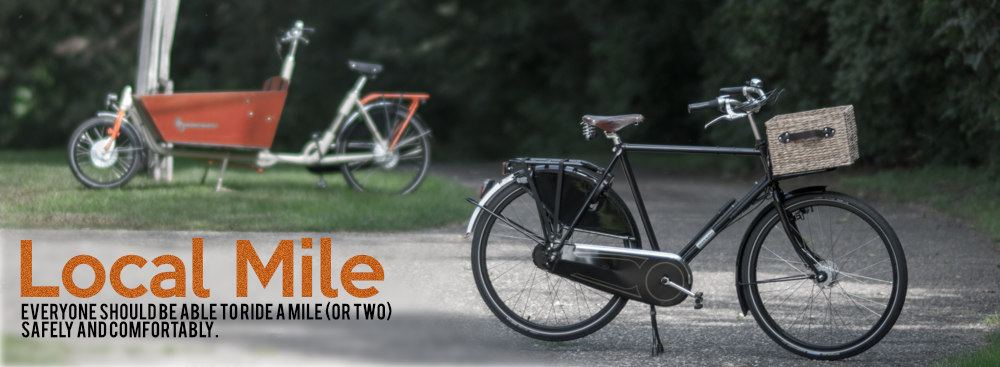[Read Time: 14 minutes ]
For the fullest enjoyment of sauna, for us individually and others, it’s important to understand sauna. Hopefully this will provide a good, somewhat brief and beneficial introduction.
If you’re anxious to just get to the sauna then skip down to ‘Going To Sauna’.
Trumpkin? One of my favorite characters in Chronicles of Narnia. If you want a sauna built properly then he is who you want building it.
Introduction
Sauna is about contrasts. The contrast of very hot vs very cold, of inside and outside, of calming, quiet, relaxing and rejuvenating vs our daily life. And with Finnish Saunas of low humidity vs high humidity. We cycle between sauna and daily life, and within sauna we cycle between extreme heat inside the steam room and cool or cold outside, and within the steam room of a Finnish Sauna we cycle between dry and humid.
Finns will frequently say that sauna is the second holiest place next to church (and that we should behave similarly quietly and calmly in each).
Sauna (a Finnish word pronounced ‘SOW-na’, sow rhymes with how now cow) is extremely popular throughout Scandinavia, Germany, The Netherlands, Austria, Switzerland, The Tyrol of Northern Italy, the Baltics and elsewhere. And perhaps not coincidentally these are also the happiest countries in the world! Finland is estimated to have 3 million saunas for 5.3 million people, about one per household. Though not as pervasive as in Finland, sauna is still quite popular throughout much of Scandinavia and Europe. As well, somewhat similar thermal experiences like Banya’s and Sweat Lodges are popular throughout the world.
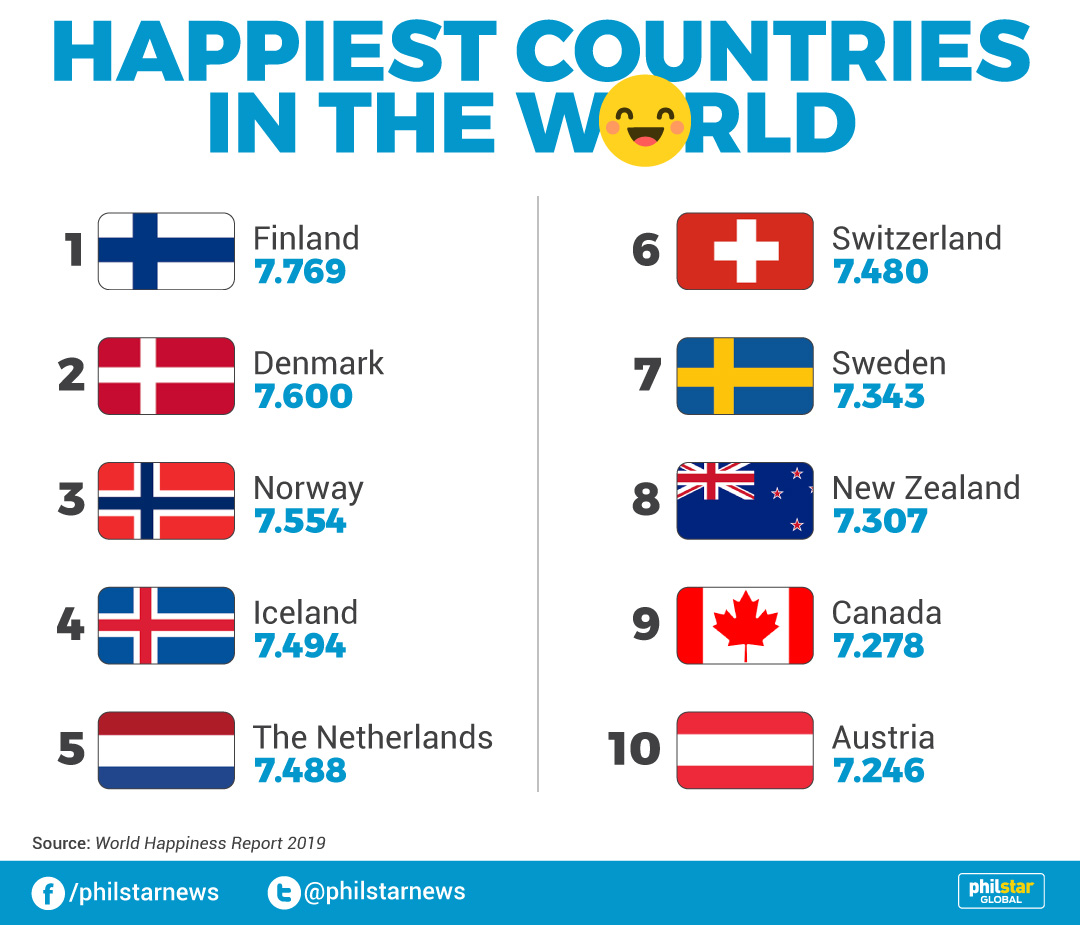 Why sauna? Primarily for enjoyment but there are some proven health benefits that come along with it.
Why sauna? Primarily for enjoyment but there are some proven health benefits that come along with it.
Sauna is enjoyable alone but is most wonderful as a social activity. Time in the sauna is often a part of having friends and family over.
Many people in Europe who have a sauna at home will still take time each week for a few hours at a public thermal suite like Therme Wien – for the broader social enjoyment as well as for the variety of thermal experiences.
Sauna is also kind of about intentionally doing nothing. Taking time to relax, unwind, and slow down. This kind of rejuvenation while awake provides different benefits than sleeping. Dutch have a word for this – Niksen. The concept (and command for Jews and Christians?) of Shabbat or Sabbath is about very deliberate rest and contrary to what I’d always thought it may not necessarily be about a specific day but about a rhythm of work/rest.
Critically, sauna is about community and a very special community in contrast to the world – For Finns, Germans and others across Europe going to sauna is kind of going to another world. A world where everyone is absolutely equal and has consideration, regard and respect for others. Being nude, we are all also equally vulnerable. Anthropologist Victor Turner says that in going to sauna we are crossing a liminal that separates us from our normal social sphere.
It is called sauna bathing because we are fully immersed in soft convective heat, we are bathed in this gentle heat, and it is truly cleansing. After a round of sauna and a dip in the lake or under a shower our skin is as clean as it’ll ever be. A few hours of sauna also cleanses us mentally and perhaps spiritually.
Finns and many others grow up with sauna bathing from about 3 months old and do so throughout their lives, typically two to five sessions per week with each session involving two to five hot/cold rounds in the sauna and cooling off. Finns say that sauna is a place for physical and mental cleansing, a place to relax, meditate and socialize.
Sauna has traditionally also been quite popular in Minnesota, Michigan and Maine thanks to Scandinavian immigrants. Around Wolf Lake and Cokato MN as well as parts of the Arrowhead region north of Lake Superior you’ll find a sauna at every home, a slight majority wood burning, and most used every day. A friend of mine grew up washing (with soap and water) in a sauna every night using water heated by the sauna heater and still does to this day. His kids, ranging in age from 2 to 18, do as well.
What Is Sauna?
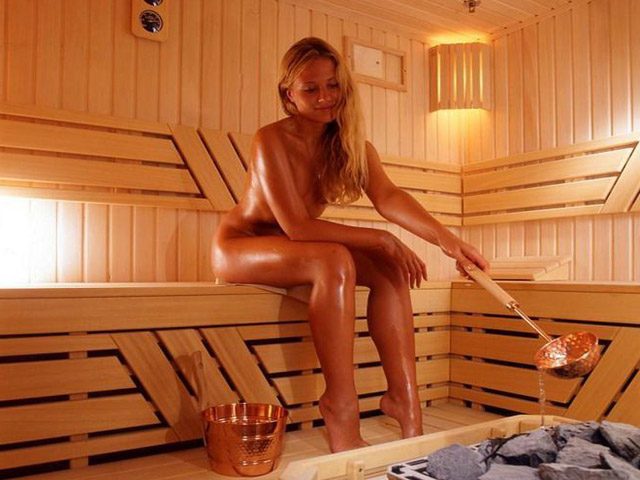 Sauna (verb in the english speaking world, not really used so much as a verb elsewhere as they will instead say ‘going to the sauna’) is the practice of sitting or laying in a sauna hot room for a short period of time, typically 10-15 minutes, until you’ve been sweating for a bit, and then cooling off in a lake, shower, roll in the snow, standing outside, relaxing in a cool room or whatever you desire. Resting for a bit, rinsing under a shower …And then Repeating as often as you want.
Sauna (verb in the english speaking world, not really used so much as a verb elsewhere as they will instead say ‘going to the sauna’) is the practice of sitting or laying in a sauna hot room for a short period of time, typically 10-15 minutes, until you’ve been sweating for a bit, and then cooling off in a lake, shower, roll in the snow, standing outside, relaxing in a cool room or whatever you desire. Resting for a bit, rinsing under a shower …And then Repeating as often as you want.
Sauna should be physically and mentally enjoyable, relaxing, invigorating and meditative.
Sauna is not a jump in the hot room once and then go shower. It’s taking our time for an invigorating ritual of hot cold hot cold hot cold.
What Is A Sauna?
A Sauna (noun) is a wood lined room, typically with stepped benches in which bathers experience a hot air bath of soft indirect convective heat that evenly caresses our entire body. This convective heat, about 75-105°c ±10°c (176-221°f) in a Finnish sauna or a bit less in a bio-sauna, is created by airflow up through the stones in the sauna heater forming a convective loop that we sit in.
Sauna’s are naturally very dry. In Finnish saunas, bathers throw water on to the stones to create bursts of steam to temporarily raise the humidity. Bio-Saunas are similar except they have slightly lower temps and a more constant moderately higher humidity.
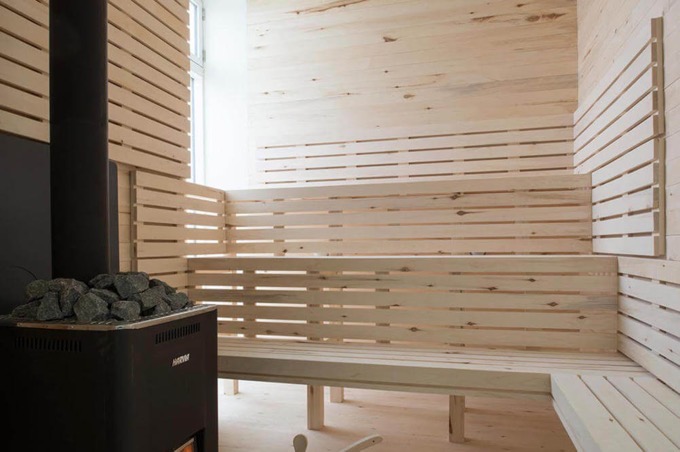 Finns say that the best way to heat the stones is with a wood fire – not because it makes the sauna itself better but simply because fire is relaxing and enjoyable. (When you sit down to dinner tonight, light a candle and see if dinner time is more enjoyable.)
Finns say that the best way to heat the stones is with a wood fire – not because it makes the sauna itself better but simply because fire is relaxing and enjoyable. (When you sit down to dinner tonight, light a candle and see if dinner time is more enjoyable.)
Traditionally this was an open fire with smoke that filled the room and so the fire and smoke had to be put out before anyone could use the sauna. Today these are called Smoke Saunas or Savusaunas and are still popular. Continuous burning wood heaters with chimneys to exhaust the smoke have largely replaced the savusaunas for everyday use though.
Electric (and gas) are also popular and while perhaps not as romantic, offer some welcomed convenience like being able to pre-heat our sauna from anywhere using an iPhone. For many people though the routine of building a fire in the sauna heater is a key part of the ritual and enjoyment of sauna – it’s foreplay.
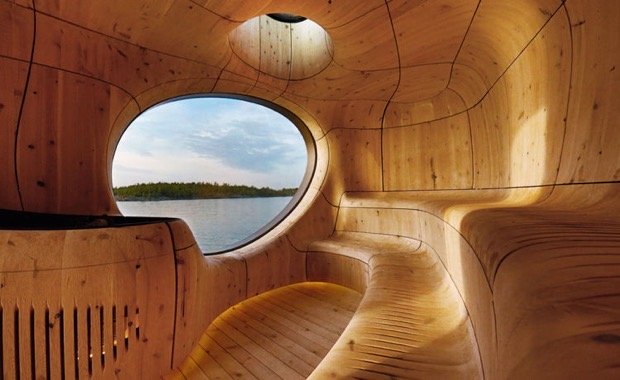 The soft woods chosen for use in a sauna for the walls, ceiling and benches are not aesthetic but functional. They don’t get too hot to touch, the hygroscopic properties help to regulate the heat and moisture for a wonderful soft (rather than harsh) heat and it helps to absorb noise for a quieter, more peaceful and less annoyingly echoey space.
The soft woods chosen for use in a sauna for the walls, ceiling and benches are not aesthetic but functional. They don’t get too hot to touch, the hygroscopic properties help to regulate the heat and moisture for a wonderful soft (rather than harsh) heat and it helps to absorb noise for a quieter, more peaceful and less annoyingly echoey space.
When you enter a sauna you’ll typically step up a few steps to a wood bench or platform. Around this platform is an 14-18” high ‘foot bench’ that should ideally be above the top of the stones. You can sit on the foot bench for cooler temps or you can step up on to the foot bench to sit or lay on the higher sitting bench for warmer temps. Some saunas may have 3 or even 4 bench levels.
When on the sitting bench you ideally want all of your body above the top of the stones – that is why the benches are so high. Finns have a saying ‘feet above the stones’ meaning that the foot bench or platform should always be above the top of the stones. When the benches are too low you’ll experience uneven heat – hotter near your head and colder near your feet and hot on your front facing the heater and cooler on your back. Being up above the stones results in a softer, more even, comfortable and enveloping heat around your entire body – what Finns call löyly.
A sauna should be located so that it’s easy to go outside each round to cool off. A separate building with a hot room and vestibule/changing/shower room is ideal but an exterior door from an interior sauna changing room works well also. One of the best parts of going to sauna is the repeating hot/cold contrast.
This is all just the technical and functional side though. A sauna should also be a room that we enjoy being in and likewise the adjoining spaces, the vestibule, changing room and shower, should be a place we desire to spend time in not just functional. Garages, locker rooms and similar places are not so enjoyable and so generally not really good places for a sauna.
Dry Sauna? There’s really no such thing. There’s just sauna. No dry sauna nor wet sauna. During each round there will typically be periods of dry and periods of humid or wet. And then there’s the fun of pouring a bucket of water over our head for a truly wet experience.
Building or Buying a Sauna? Check out Trumpkin’s Notes On Building A Sauna, Kit Sauna Reviews, Notes on Barrels and Notes on IR Booths.
Löyly
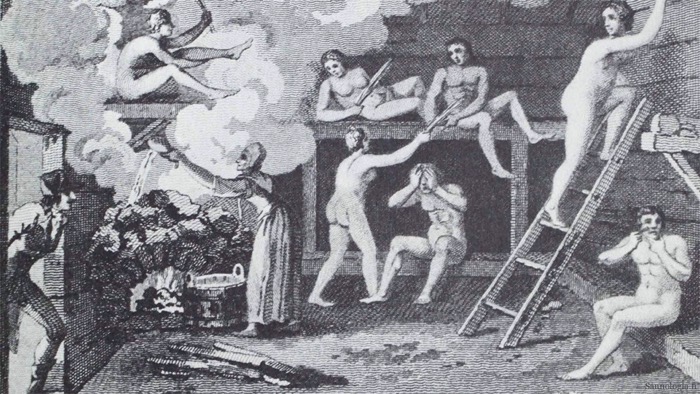 Löyly (pronounced kind of like ‘l – eu -i -loo’. Almost like Lou-Lou but more nuanced.) is a special word in Finnish for the environment in a sauna. It is “the purity, freshness, temperature and humidity of the air in the sauna”.
Löyly (pronounced kind of like ‘l – eu -i -loo’. Almost like Lou-Lou but more nuanced.) is a special word in Finnish for the environment in a sauna. It is “the purity, freshness, temperature and humidity of the air in the sauna”.
The air in a sauna should always be fresh, not stale and the temperature about 80-105°c at bathers heads. …Or 70 or 120°c if that’s your preference. It should be pure with no excess CO2, particulate matter, chemicals such as chlorine, perfumes, detergents, mold, or cleaning products.
Bather’s bodies should be enveloped in convective heat evenly from head to toe, front to back and second to second.
The steam from the stones is a critical element of löyly and so the environment in the sauna is not considered löyly until this steam has been added. It is not unusual for people to shout ‘LÖYLY!’ when this is done (and is perhaps the only way to elicit verbiage from a Finn:-).
There is a popular saying among Finns, Swedes and others that “90% of the saunas in the U.S. are bad and the other 10% are worse” – that not a sauna in the U.S. has löyly. Sadly this is largely true and is referring to lack of proper fresh air ventilation (that results in suffocatingly high CO2 levels) and temps and benches that are too low. Once you’ve experienced proper sauna and löyly you’ll never want to go back! Fortunately U.S. saunas are starting to improve.
Fun Stuff: The image above from 1799 is by Giuseppe Acerbi who added himself as the clothed intruder, holding the door open, letting in cold air and letting out heat and steam.
Sauna Temperature
Finns don’t ask what the temp was, they don’t really care, they ask how the löyly was.
‘The temperature’ is actually not that important. Far more important is that the temps on bathers bodies are fairly even head to toes and front to back and minute to minute, that the air is fresh without high levels of exhaled CO2 or built up moisture, bathers are experiencing the convective loop and steam descending down on them from the ceiling and are not experiencing any noticeable radiant heat.
In other words, the quality of the heat and environment. These are the elements of good löyly and what distinguish a sauna from other forms of sweat bathing.
The official recommended temperature from ISA is 80-105°c (± 15°c) (167-221°f (± 25°f)) – measured at a point 1m (39”) above the middle of the longest sitting bench opposite the heater. The ± portion is actually not part of the official definition (see below) but experts I’ve talked with including Risto Elomaa, Chair of the International Sauna Association, all agree that this bit of variation still fits within a liberal interpretation of what is a sauna.
Another way to look at it for a Finnish Sauna is that the proper temperature is one that results in someone staying in 10-15 minutes. Less than 10 minutes is perhaps too hot, more than 15-20 minutes is not hot enough.
The best temperature though is whatever you desire. If 60°c is your thing then that’s what you should do and enjoy it even if it may not officially be sauna at that temperature. I encourage you to occasionally experiment with different temps though. As you become more experienced and acclimated you may find that 82°c or 94°c is quite enjoyable.
Note that when outside humidity is high then the base humidity in the sauna might be higher than normal and so slightly lower temps might be a good idea. So while we might normally do around 96°c in our sauna, on a very humid summer day (91% RH) we find 80°c a nicer temp.
Women generally prefer lower temps than men and are often more sensitive to head to toes differences. In Finland it’s common for women to sauna first and then the sauna will be heated up a bit for those, both men and women, who want higher temps. When everyone want to be together then a temp between the two is often chosen.
The larger the sauna the more comfortable higher temps are as the temps are more even and there is less incidental radiant from the front and side walls and from the heater.
Hot Feet – The foot bench should be somewhat hot. If it’s not then your feet and legs won’t be hot enough. Many people place their towel so that they sit on it and have their feet on it as well. This is not only better for reducing sweat (and required in many cultures) on the benches but protects our feet.
Another alternative is when you sit with your feet on the foot bench it can help to very briefly raise your heels and then put your heels down and very briefly raise the front of your foot. Two or three times doing this is usually sufficient for your feet to acclimate and be comfortable. If the foot bench is too hot for this to work then it is likely getting too much radiant heat from the heater.
Cold Feet / Hot Head – In a sauna with too much stratification, usually from too low of benches and ceiling, and sadly common in North America, our body will perceive temps as hotter than they are. Our body wants to be in homeostasis – equilibrium – and if our head is more than about 15-20°c warmer than our toes it will react to this temperature difference rather than to heat in general. That’s not what we want in a sauna.
Nature
Sauna has historically had a strong connection to nature. Often stated as Wood, Stone, Fire and Water. We are also learning more and more how important being in nature, sunlight and moonlight are for our mental and physical health. Spending time outside, typically for cooling down, is an important part of a sauna experience.
Sauna Community
Sauna provides for a very unique, wonderful and beneficial social community. Almost like a third space on steroids and one in contrast to much of our daily lives.
The atmosphere of total relaxation and genial sociability which prevails in the sauna provides an opportunity to approach many different aspects of life, and encourages open discussion of divorce topics.
– Antti Arstila
We are all sharing a rather small space. For this to work well requires cooperation along with regard and consideration for others.
We are all equal and if nude equally vulnerable. Nobody is greater or lessor than any other. There is no status, rank or wealth in a sauna.
We are, or should be, sitting still and quiet. This provides a natural and unique opportunity for quiet conversation and interaction that doesn’t happen elsewhere. Even when there is no conversation there is acknowledgement of each others presence and that we are all in this together for our mutual community benefit.
Any conversations should be of a topic, and preferably language, that everyone can participate in. If two people are discussing a matter specific to themselves and someone else comes in then they should (and almost always will) change the topic to something that the third person can participate in.
Going to The Sauna
Going to the sauna should be relaxing and enjoyable and can be solitary or social. It is NOT A CONTEST. It is not a regimen to be endured.
The enjoyment and health benefits of sauna come not from just sitting in the sauna but from the repetitive rounds of heating up and quickly cooling down. You sit in the sauna for the experience of quickly cooling down in a cold lake, not just for the experience of sitting in the sauna.
Some Finns will say that anything short of Hot Cold Hot Cold Hot Cold (3 rounds) is not sauna. This is perhaps the number one thing about sauna that Americans often miss. People in American gyms will get in the sauna for a bit and then take a warm shower. Or maybe do one cold plunge and then a warm shower. That’s not really sauna according to Finns and Swedes.
The hot room and time in it is actually fairly minor. Other places and elements like a dip in the lake, a walk in the snow or a cool shower often comprise more sauna ritual time than the hot room. You should allow at least one and ideally two to four hours or more per sauna session so that you have time to enjoy multiple rounds in a relaxing way without feeling rushed.

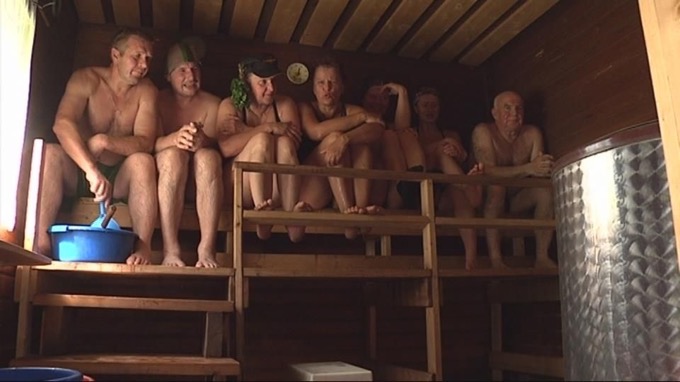
1) Warm Up The Sauna:
Our sauna, like most, needs to warm up about 60-90 minutes prior to use. Ideally you want it to have been at your desired temp for at least 30 minutes so that the stones and walls have time to fully warm up. That said, I’d not let warm up time stand in the way of a sauna session if time is tight.
2) Before Sauna:
Hygiene Before Heat – Or ‘first shower, then sauna’. Shower with soap before first entering the sauna for the first round and then rinse well. As my father-in-law would say “as far down as possible, as far up as possible …and possible”.
Why shower if you’re just going to get sweaty? Bacteria. Our bodies can build up a significant amount of bacteria (it’s the primary ingredient in BO). But you also want to get off any makeup, chlorine, sunscreen, cologne, dirt or other gook.
This is especially important if you have suntan lotion on or have been in a chlorinated pool or hot tub. You (and your sauna mates!) want your skin and pores to be as clean as possible. You’ll not necessarily need soap after this, though some people do choose to wash with soap after their final round.
Fun Debate I: To dry or not to dry? Many Finns enter the sauna dripping wet from their shower, others have a strong belief that you should dry off first. This one I think, despite it seeming almost religious to Finns on both sides, is personal preference. I do both and I’m not sure there’s much difference. I do always dry off if I’ll be standing outside in cool/cold temps though which I often do.
Drink water! It’s a good idea to wait a couple of hours after a meal but a light snack just before sauna is fine. Many Scandinavians will drink beer or Finnish Long Drink during their sauna sessions and roasting sausages on the rocks is a sometimes Finnish tradition but these are totally optional. Be cautious of alcohol though as drunk + sauna heat is not a good thing. High CO2 that’s common in U.S. saunas makes the affects of alcohol much worse.
If you’re wearing a swim suit (sauna is typically done nude) then it should be freshly clean (ideally with non-scented detergent) and not have been in the hot tub or any other chlorine source.
ALWAYS wipe your feet well before entering the sauna to keep the benches clean (and NEVER wear sandals in to the sauna).
3) In The Sauna (5-20 minutes):
Always sit on a towel, even if wearing a swimsuit.
Sauna is typically done nude but swimsuits are acceptable in North America for those uncomfortable with nudity (for more: Sauna’s, Nudity and Victoria)
Stay in as long as you are comfortable and leave when you want or when jumping through a hole in the ice sounds like a really great idea. There is no magic time to spend in a sauna and it may vary from day to day. Finns and Swedes consistently say 5-20 minutes and I’ve been told by a few people to not stay in longer than 15-20. While my preference is 10-14 minutes at 94-98°c (200-210°f), I sometimes like to stay in longer with cooler 75-80°c (167-185°f) temps and sometimes 8-9 minutes at 112°c (233°f) is my thing.
If you find that you are able to stay in longer than others that may just be that you’ve more body fat and less muscle. Muscle transfers heat better than fat so someone with more muscle and less fat will heat up faster internally. The next time you hear someone bragging about how long they can stay in a sauna, think about this 🙂
In Scandinavia children are taught “in the sauna you must be as quiet as in church”. A Finnish friend told me “Silence is Gold, Talking is Silver.” Quiet conversation is wonderful as is sitting in total silence. I love both.
Steam (the final element of Löyly)
Steam in a well designed sauna is quite wonderful as you feel it envelope your body in its caressing warmth.
Ask others before throwing water on the stones. It’s impolite to throw water on the stones and then leave or for anyone to open the door for the first two or three minutes after throwing water on the stones).
Some natural eucalyptus oil or other natural infusions may be added to the water bucket – typically about 1/2 to 1 dropper full. We use only pure natural oils, I am not a fan of Rento and other scents with unnatural chemicals. Alternatively you can add some birch leaves or redcurrant.
CLOSE THE DOOR! Finns have a number of special epithets for those who keep the door open too long.
- Löyly menee harakoille – “the löyly is going to magpies!”.
- Lämpö karkaa – “the heat escapes!”.
- Ovi kii – “Close the door!”
- ovi perkele – “The door you devil!”
- Sulje se vitun ovi! – “Close the damn door!”
- Oletko syntynyt sikalassa, ovi kiinni – “Were you born in a pig sty? Close The Door!”
3.1) Optional: Cooling In The Sauna (1 second):
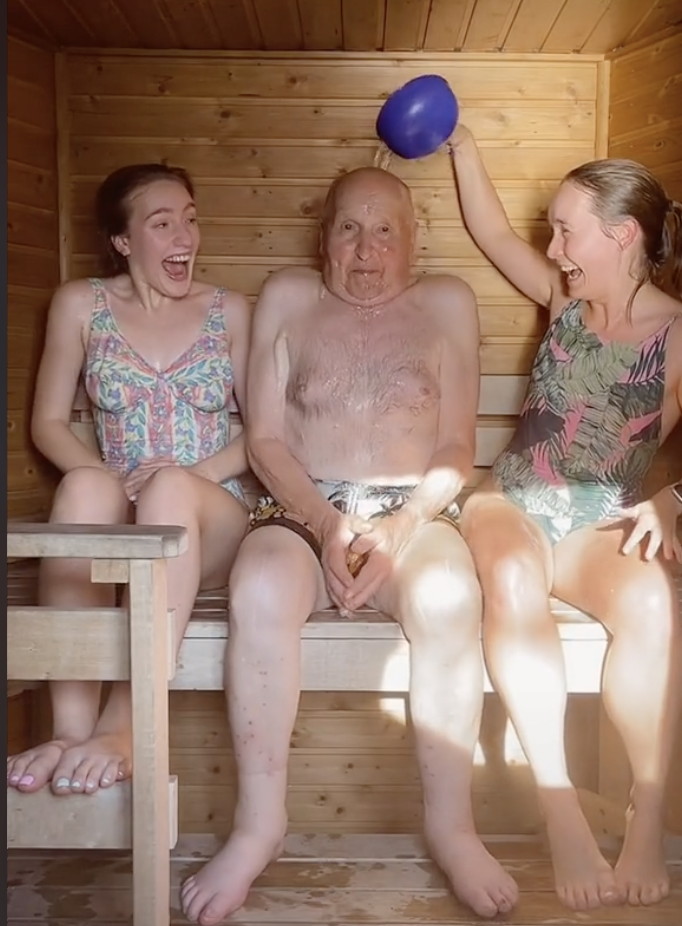
There’s nothing like getting warmed up well in a sauna and then pouring a bucket of cold water over your head (or having a cute Finnish singer do it for you). Shocking for about 1 second and then wonderful enveloping warmth.
Only do this in a sauna with a proper drain though.
4) Out Cooling Down (5-60+ minutes):
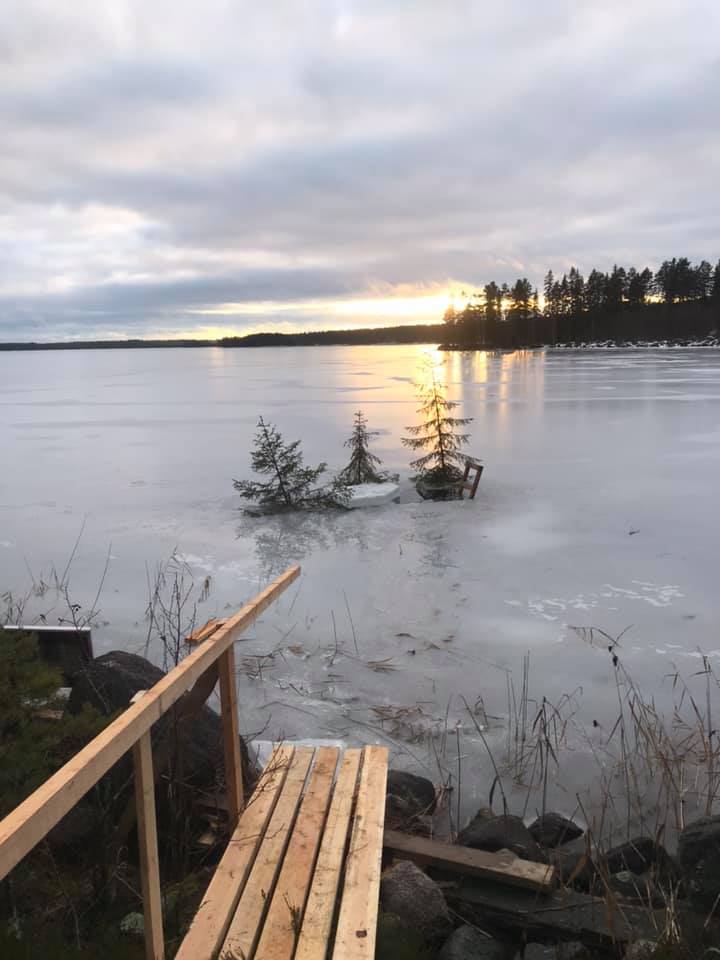 Go jump in a lake! Really. No matter how cold it is. If it’s frozen we’ll cut a hole in the ice (and maybe plant a warning tree forest like my wife’s cousins Mikael and Maria do in Sweden)*.
Go jump in a lake! Really. No matter how cold it is. If it’s frozen we’ll cut a hole in the ice (and maybe plant a warning tree forest like my wife’s cousins Mikael and Maria do in Sweden)*.
My friend Kimmo (SaunaSherpa – check them out for a tour) notes that Finns even have a special word for a hole in the ice to go swimming in – Avanto! Not to be left out, Swedes have their own word for a swimming hole in the ice – Isvak! Kimmo adds “A slight push outside one’s comfort zone can be intimating – both in sauna, as well in avanto to get deeper sensations. For avanto first timers: enter steady, determined, stay calm, remember to breathe(!), Hardly anyone enjoys staying in the water but jumping in is worth it as bliss/euforia comes as a reward afterwards.” He also notes that some people never get fully use to it.
Feeling a bit of trepidation on your way to the lake, like this is going to be cold and I’m nuts for doing this, is a good thing. That means that you’re in for a treat. It’s indeed a bit intimidating but well worth it.
Ideally you want to preserve as much sauna warmth in your body as possible when you jump in the lake. Taking a cue from firefighters, I always hang my swimsuit with strings up so I can get in it quickly (yeah, good idea to pull a swimsuit on before heading to the lake during the day in North America) and I’ll wrap my drying towel around my shoulders for the trip down. A terry cloth robe can work better.
Next best is perhaps a cold plunge pool. Large enough that you can easily get your whole body in quickly. Personally I’ve found 12-18°c (53-64°f) to be about ideal and this is also the temp found at most thermal suites in Europe. Well, actually 16-18°c seems most common and for enjoyment that is kind of ideal. I’ll still jump in colder than 12°c and while still enjoyable, not as much for me personally as a bit warmer. The heat shock protein folks say that it should be below 12°c – however; 1) I’m doing it mostly for enjoyment, 2) health benefits are mostly a bonus for me, and 3) the benefits of such cold temps so far appear theoretical rather than proven.
Our lake is around 4-8°c for a few weeks after ice melt which I find OK but look forward to it warming up. For safety it’s not unusual in Scandinavia to have a rope with a hand loop laying next to the ice hole that’s tied to a tree. Some people will grab the rope when the jump in.
If possible a cold plunge pool should be about 1.25m deep. Outside (and ideally in-ground) is best in my opinion but inside works well also. Some way to freshen the water and remove sweat and bacteria such as a recirculating filter system is a very good idea, especially if it’s shared.
Or go under a cool or cold shower. You ideally want to cool off quickly. Yep, it’s a bit shocking for 2 seconds and then you feel great. If you’re a loofa person this is ideal loofa! Two to five minutes under the shower and then walking outside to dry off and finish cooling down is a wonderful experience.
When you shower after your first round you may smell some body odor. This is not sweat (sweat doesn’t smell) but bacteria in your skin that soap didn’t remove (and possibly bacteria from soap). You’ll not smell it after further rounds!
Or no water necessary. Popping outside for a bit, rolling in the snow, relaxing on a lounge chair are all options.
If it’s below about 40-50°f then you may find sandals outside to be a good thing.
If it’s below about 10°f (-13°c)… drying off before going outside is a good idea. Be careful grabbing cold metal door handles with wet hands. And yes, that is ice in your formerly wet hair.
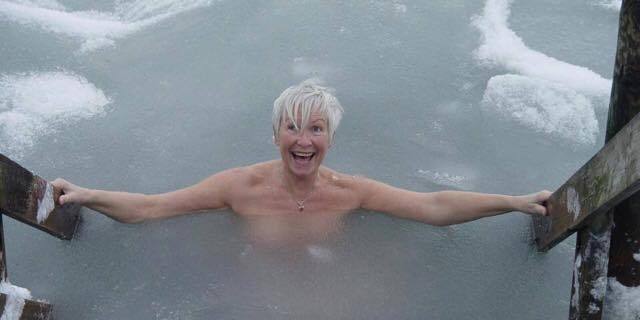 A great experience is lake water about 40°f (4°c) and air 20-40°f (-6°c – 4°c) but almost any weather will do.
A great experience is lake water about 40°f (4°c) and air 20-40°f (-6°c – 4°c) but almost any weather will do.
Remember to take a few deep breaths of fresh air while you’re outside.
The first round is kind of an acclimatization round. Your body is relaxing and waking up at the same time, your pores are opening. In a well designed sauna with good ventilation the subsequent rounds will get better and better with each round.
When doing any kind of a cold plunge – sea, lake, shower, tub or bucket of water – a key is immediate total immersion.
4.1) Shower After The First Round (Before Pool):
Our first round rids us of a lot of bacteria so it’s good to rinse well in a shower immediately after our first round and before entering any pools. It’s OK to go directly to a lake or sea though.
If we are nude and otherwise practicing good hygiene then for rounds after the first we can usually go directly to a plunge pool as any bacteria on our body will be minimal. Some facilities may still want you to shower first so best to check to make sure.
5) Repeat:
Repeat as often as you want. Three rounds is kind of the average but two, seven or whatever is OK. Even occasionally doing just one round is fine.
In Finland and elsewhere it’s not unusual, especially at a lake cabin, to spend pretty much an entire day going back and forth to the sauna. It’s kept ready all day and in to the night for whomever wants to use it when. I can be quite content spending an entire day at a thermal suite doing visits to a Finnish Sauna, Bio Sauna or Steam Room every 30 – 90 minutes.
Hydrate with every round. Or not. Some people believe it’s best to hydrate well before your session and then not again until after all of your rounds. Personally I think it best to drink a bunch of water with each round.
Warm up slowly. While a very quick cool down is wonderful, the opposite is not so true. Warm up in steps including a minute or ten in the changing room letting your body warm to that temp. Only then enter the hot room and spend a few seconds at the lowest level before slowly climbing up in to the heat of the löyly cavity. This gradual entry to the heat makes for a much more enjoyable sauna experience and avoids the risk of afterdrop.
6) After:
After your last round there is no necessary need of soap. Just rinse off well under a cool shower and you’re as clean as you’ll ever be and much cleaner than after a typical soap shower. Many people find the feeling of totally clean and clear skin with open pores and no chemicals quite wonderful.
Many people do however prefer to use soap or shampoo afterwards. It will not remove any more sweat than just water and it will clog your pores but many of us just don’t feel clean if we’ve not used it. Some people like it just for the fragrance and some rinse with water but shampoo their hair for the shampoo fragrance. This is all personal preference.
Don’t forget to take time to cool down before your final shower as you’ll continue to sweat for a bit. Many people do a cool shower immediately after their last round and then wait 20 minutes or so before their final shower and getting dressed.
Hydrate! Water or maybe a beer, Finnish long drink or glass of wine if you like.
This is a great time for a nap or a relaxing read. Most importantly, enjoy the blissful post-sauna feeling of having cleaned both your body and your mind.
Here’s an alternative routine from The Finnish Sauna Society:
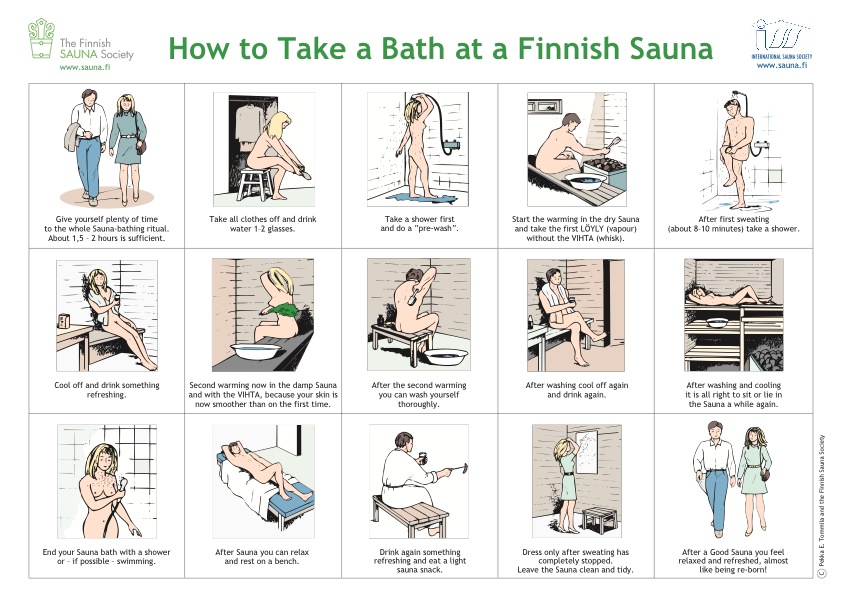
And, given American sensibilities and judgementalism, perhaps no discussion with others about who wore what or not in the sauna.
Sauna Etiquette
The key to sauna etiquette is consideration and regard for others.

- Rinse off or shower before each round (with soap the first time) to remove bacteria.
- No sandals or flip flops on the benches – clean bare feet only.
- If not nude then wear as little as possible (to reduce bacteria growth, BO and other contaminants).
- Open the door only as much as necessary and close it quickly so heat doesn’t escape nor cold air freeze others toes!
- Sit on a towel (even if wearing a swimsuit) so you don’t leave any sweat (or other) on the bench.
- In Continental and some other saunas one under your feet as well.
- Ask others before throwing water on the stones!
- Only fresh clean water, optionally with natural aromatherapy oils, may be thrown on the stones.
- No earphones. In the sauna is a community that we should not separate ourselves from.
- Talk and behave quietly and calmly as you would in church.
- Conversations should be of a topic that everyone can participate in. No private conversations.
- Politics and religion should generally be avoided unless only with close friends and family.
The First Time

If this is your first time then take it easy, maybe sit on the lower bench if you want, and don’t push how long you stay in the sauna. Different people have different tolerances and the more you do it the more you’ll get to know your body and what you do and do not enjoy.
Maybe take it slow with jumping in a cold lake or under a cold shower. The shower’s easy – adjust the temp up some (about 10 o’clock on ours in the black tile shower or the one just outside on the patio). You can’t turn the temp up on the lake so I’ll take back what I said earlier about taking it slow – jump in and enjoy!
Sauna can take some getting use to. For many people it can take two to five 3-round sessions to learn to really enjoy it. People who’ve done it for decades often comment that it continues to get better and more enjoyable year after year.
Going to the sauna may differ each time. Some days we may want to do six rounds and another day decide that one round is enough for that day. And this is OK.
While from a health/medical standpoint it’s generally recommended to stay in the heat no longer than 15-20 minutes per round, it’s OK for most people to occasionally do so.
Regimen, Ritual and Grounding
This is one place where we may sometimes need to be different from Finns. Finns, Swedes, Estonians and others have a culture of going to sauna. They do it frequently and have for their entire lives. Going to sauna is embedded in their being. And perhaps most importantly, they frequently experience many different saunas and sauna rituals with friends.
Finns rarely talk among themselves about how many rounds they do or how long they stay in. They know. They are also big on freedom and ‘doing what feels good’ whatever that is. However, if you go to sauna with a Finn you will almost always do three or four rounds of 10-17 minutes in the sauna and 15-45 minutes outside cooling down. Finns say that there is no ‘average’ sauna ritual. …but there is.
These are actually quite huge benefits. And we lack them.
For Americans it’s easy to develop not so good habits (or start with them) or to forget how good proper sauna can be. This especially with our rush-to-this-rush-to-that culture. It’s good for us to occasionally plan two or three intentionally ‘average’ and relaxing sessions of three or four rounds and taking at least 30-60 minutes per round split between hot/cold and perhaps 2-4 hours overall to help stay grounded. Finns get this grounding naturally as part of their culture, we do not.
It’s Not Sweat That You Smell
How do you get rid of the smell of sweat if you don’t use soap after your last round?
The smell that we associate with sweat is not sweat but bacteria. Bacteria thrive in warm places like folds of skin or skin sweating under a swimsuit unable to breath. When you sauna and then rinse off with cool water you get rid of bacteria that soap can’t.
This is why for instance people can ride an upright Dutch bike in hot weather and not smell offensive. Firstly they don’t sweat as much as someone who’s leaning forward and wearing a helmet because they don’t get as hot – even if they’ve been riding the same speed. The big thing though is that they’ve not given bacteria a chance to grow. Leaning forward creates skin folds and reduced cooling both of which lead to bacteria gardens.
Attire
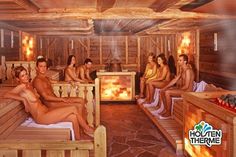
In most countries everyone enjoys sauna together nude and nobody gives it a second thought. People sauna without clothes because it is more comfortable, more hygienic and brings an element of equality that can’t be achieved in any other way. For many and perhaps most regular sauna goers nudity is, for those three reasons, fundamental to good sauna.
“In the sauna nudity is not the objective; it is simply a necessary condition for bathing properly”
– Bernhard Hillila, ‘The Sauna Is’
Other culture’s comfort with nudity seems strange to those in the english speaking world, especially Americans (just as our fear of nudity seems strange to others). Nearly all become comfortable with it once they try it though. A common thing seems to be that the first few seconds is kind of scary (or terrifying according to some) but within a minute it becomes more comfortable and after ten minutes it’s a non-issue. I think once you’ve been around a dozen or three nude folks in a normal non-sexual environment you don’t think about it. I’ve probably seen several thousand people nude at various saunas and never give it a thought.
Individually it is more comfortable in the sauna because swimsuits or towels wrapped around us keep our skin from breathing and cooling us. This can also create uneven heat across our body which isn’t so comfortable. Finns and others say that you cannot experience löyly if you are at all covered. FWIW, everyone I’ve talked to who has done both many times prefers, often strongly, nude.
Outside, exposed skin dries fairly quickly making it enjoyable to stand outside, swimsuits not so much. A wet swimsuit just isn’t comfortable, especially when it’s cold or breezy and doubly worse when dripping cold water down our legs.
The time spent out of the sauna cooling down between rounds is as important as the time spent in the sauna hot room and an uncomfortable cold wet swimsuit can make this time less enjoyable and shorten the amount of time you want to stay outside.
This also makes the routine of showering (with soap before sauna, rinsing well after or before each round in the hot room, and before getting dressed) a lot easier and more beneficial. The sweat glands that result in the most bacteria are the apocrine glands in our genitals – rinsing these areas is particularly important, for us and others, and that’s impossible when they’re covered.
In public thermal suites this also allows the use of salt electrolysis systems rather than harsher additive chlorine. This is not only healthier for us and eliminates itchy dry skin and hair problems but also eliminates the smell of chloramine from pools.
There are two elements for hygiene. First is that having all of our skin exposed to air eliminates the bacteria growth that happens under swimsuits. One of the great things about sauna is that we get rid of all of this bacteria that has built up since our last sauna – and that’s good and healthy for our skin.
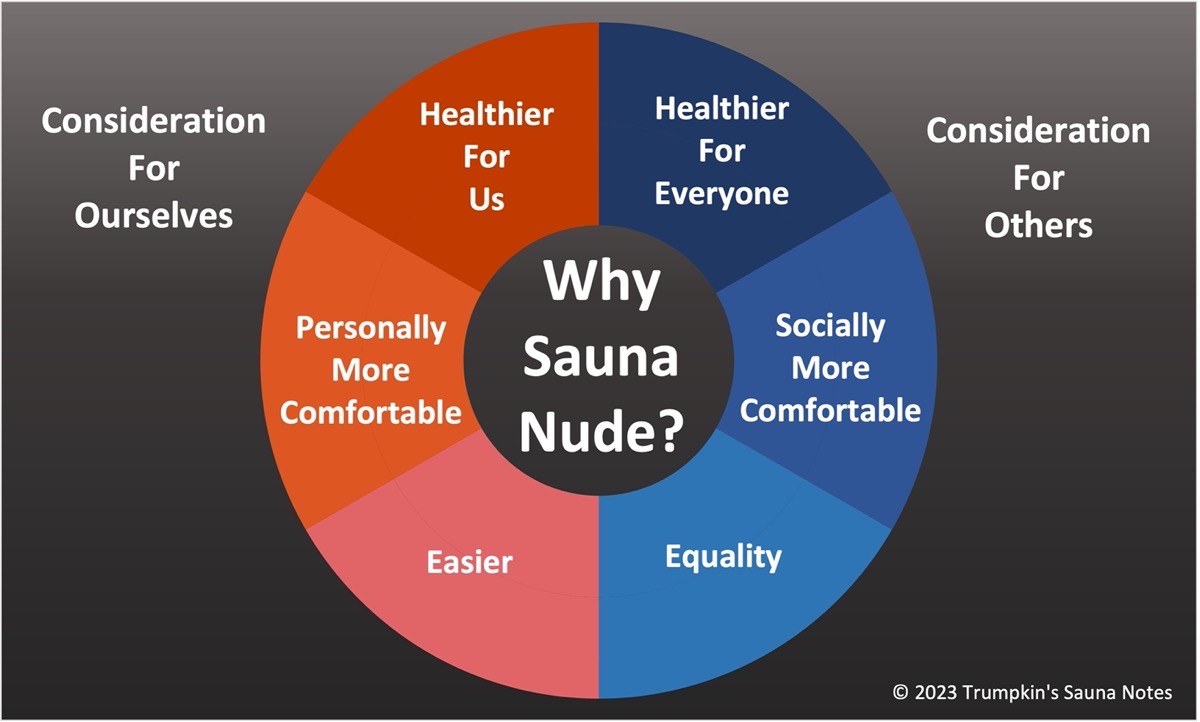
Why require everyone to be nude as is the case with about 97% of saunas in the world?
Cloth that is not freshly cleaned with unscented detergent can bring unappealing scents and bacteria. The smell of bacteria, chlorine or other things that swimsuits and the skin under them can harbor can result in an unpleasant and unhealthy atmosphere – kind of like cigarette smoke². People who are nude also shower/rinse better than those who are wearing a swimsuit.
Being naked makes us somewhat vulnerable, which is itself good and brings a surprisingly critical element of equality. It’s best and most comfortable for everyone then, particularly women, if everyone is equally vulnerable. Interestingly the people in Europe who are quickest to sound the alarm are women – they don’t want to wear a suit themselves and don’t want the discomfort of being around others who are.
This is why most public saunas forbid swimsuits, not just recommend not wearing them.
Cultural Differences – Continental saunas, public and private, are universally mixed nude except for tourist saunas.
In Finland, immediate and extended family or close friends are mixed nude. “Finnish families including cousins, aunts and uncles all sauna together naked – everyone, from grandparents to tots as young as four months old.” Friend groups vary, some are mixed nude while others will separate by sex. Beyond this Finland’s default is separate male & female or female first then male or mixed, but just mixed if all are comfortable with it. Sometimes separation in time is more about temps with those preferring lower temps (bio sauna) going first. You will find public saunas in Finland that allow or require swimsuits. If you are visiting a family or friend group who normally sauna mixed nude, they will often ask your comfort level and will separate if anyone is uncomfortable with mixed nude.
“It’s perfectly normal to go to sauna mixed nude, and perfectly normal to separate by sex.”
– Finnish Friends
Nordic falls kind of between and overlaps Finland and Continental. Mixed nude is more common than in Finland but I you’ll find a variety of practices depending on the group you’re with.
In the U.S. and somewhat in the UK, Canada and parts of France and Japan (blue in the charts below) people are more likely to wear swimsuits though this is slowly changing.
Here is a rough estimate of what you’ll find where.
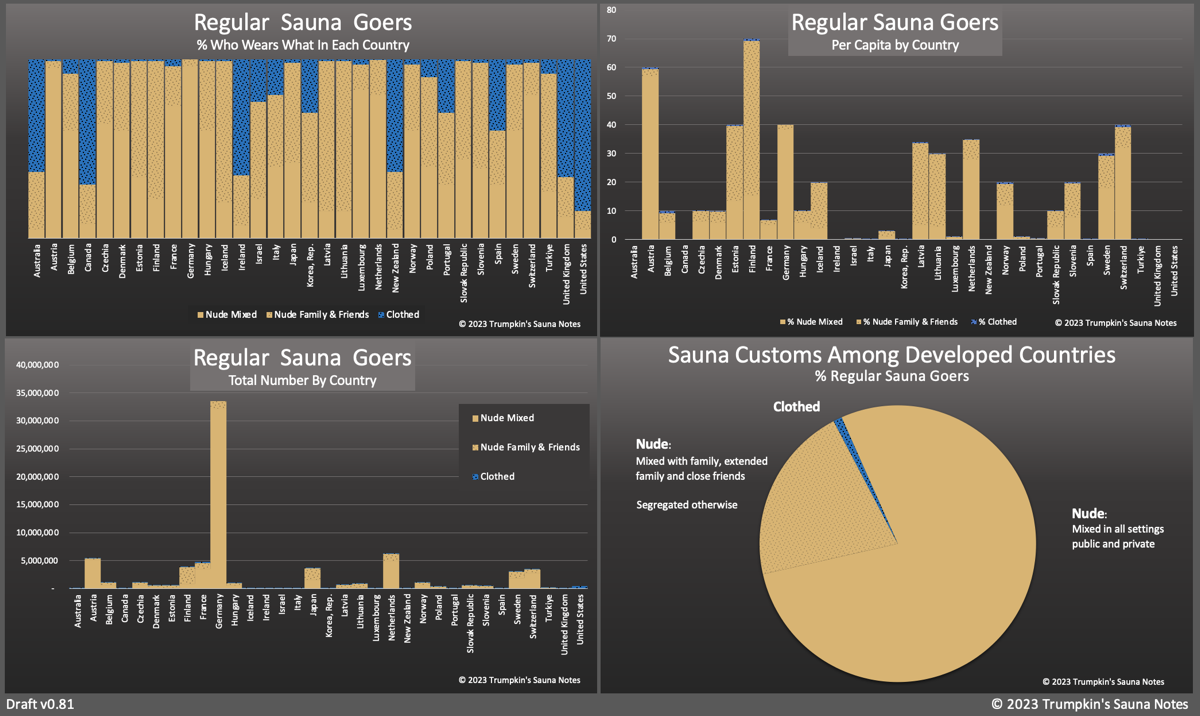
For mixed sex public saunas in Europe there are some clear male / female differences. In Continental saunas most of the men and a some of the women will walk around nude while many of the women and a few men will wear a robe except when in a sauna or showering.
If there are 18 German couples in an Alpine resort (continental sauna), all of the men will go to sauna but only perhaps a dozen of the women and one or two of these women will keep a towel fully or partially wrapped around themselves. If 18 Finnish couples then maybe only half of the women will go to sauna. One element of this is that women can be more uncomfortable with nudity than men. As well, from conversations with a number of people, it is clear that women don’t care who sees their husband nude but some men aren’t so comfortable with other men outside of immediate/extended family seeing their wife nude.
Nude but wrapped in a towel, pareo or sarong can be a good option. On the very rare occasions that Finns, Swedes or others wear anything they seem to be equally divided between these or a swimsuit noting that with a towel, pareo or sarong they can open it up as needed to let their skin cool.
If you wear a suit. Breathability and fast drying are important and you want to cover as little skin as you are comfortable with.
For guys; briefs (‘speedo’) are best but a tight fitting square leg, square cut or boxer (three names for the same thing) is a bit more modest and works well to avoid uncomfortable cold drips. Jammers are probably third best (Tyr’s short Jammers are good) with loose trunks or board shorts the worst.
For more on nudity, the differences between the U.S. and other countries, and the differences in natural, erotic and sexual nudity: Sauna’s, Nudity and Victoria
The default for our sauna is whatever everyone is comfortable with. So nude mixed, women first followed by mixed, or swimsuits. We can also setup separate male/female/family times if people want to give it a go in private.
FWIW, we are fine with whatever and most important for us is enjoying time with family and friends. We much prefer to sauna with friends and everyone wearing suits than not sauna with friends at all.
The sunken sauna patio is fairly well protected (and will be better protected when new plants grow), especially the outdoor shower area. So there, the lower level of the house and of course in the sauna and changing/shower you are welcome to wear whatever you do or do not want. Beyond these a towel, shorts or swimsuit is a good idea. If it’s dark out then two presses on the ‘exterior’ button will turn down the outside lights and then a towel or robe is sufficient to get safely down to the lake. It’s easy to get comfortable walking around or laying in the sun in the sauna patio and then deciding to go for a dip in the lake so be thoughtful to not wander off without your suit on 🙂
Euro Zone – When people are using our sauna: the sauna, sauna patio and the lower level may be a Euro Zone – you may encounter naked people. Be forewarned if you’re easily offended. 🙂
No Judgement Zone
Many people are comfortable in sauna without clothes, others are not. Some are comfortable around others who are nude, some are not. Some guys are not comfortable with other guys, particularly similar aged guys, seeing their wife nude, some aren’t bothered in the least.
NONE of these are right or wrong. Nobody should ever be judged in any way nor should anyone feel pressured to do anything they are uncomfortable with.
Jewelry & Electronics
It is generally best to remove jewelry before sauna. Some, depending on the material, can get hot and be uncomfortable. VHP’s and similar piercings that are somewhat protected do not generally seem to be a problem and other piercings depend on the material and location. The first time you sauna with a piercing it’s a good idea to keep your mind on it so that you can exit before it gets too hot.
Electronics generally don’t do well in the heat & humidity. Electric saunas in the U.S. are typically not as hot as those in Europe thanks to UL regulations and with lower benches have greater stratification so it’s something like a sport watch or Fitbit is more likely to survive.
Infusions, Fountains and Snow Balls
There are a number of infusions or scents that can be added to the water in the water bucket for the steam. Eucalyptus is quite popular. A small group of us like mixing Tar and Sauvusauna.
Those from Emendo and Osmia are quite good. I think almost any pure organic oil can work well. Personally I would avoid Rento as they tend to have a fake chemically smell and I also wonder about potential health aspects.
There are a variety of bowls, saucers and fountains that can also be used by placing them on top of the stones anding some infused water.
Snow and Ice balls are a favorite of mine. These can be placed on top of the stones so that they melt and provide a constant bit of humidity. Infusions can be added to these as well – dripped on a snow ball, mixed in with the water for making ice balls or with the Saunagutt Snow Ball maker you can put some in the indentation made just for this.
Music
This is mostly personal preference in our personal saunas at home. However… One of the great benefits of sauna is a period of quiet and calm in contrast to the noise of daily life. It’s a time to sit quietly, think, contemplate, meditate and relax. A time to let our brain recover (and yes, this is different than recovery while sleeping).
Sauna is social. Someone wearing ears in a sauna is mentally segregated from the rest. They’re not connected. Even when no words are spoken there’s a difference between someone in their own world, disconnected from everyone else, listening to music or a podcast vs someone who’s not and is thus connected with everyone else. People outside the U.S. consider it rude to wear any kind of earphones in a sauna.
There’s a special community vibe in saunas and this is degraded when anyone separates themselves by wearing ears.
Even the quietest earphones and inducers can often be heard by others in the quiet of a sauna. This is quite inconsiderate of others.
Noise generally has a negative effect on our cognitive ability. This is mostly temporary though there is some evidence that continued exposure, such as frequently having louder music in our ears, may result in permanent cognitive decline. Interestingly, music at a lower level and ambient rather than directly in our ears can sometimes improve cognitive ability.
Fun Debate II: Throw vs Ladle
I was originally taught to somewhat slowly ladle water on to the stones so as not to ‘kill the stones’. Then some other Finns told me to just throw it on. And recently Kimmo mentioned again ladling rather than throwing. So what’s a person to do?
Throwing ladle fulls of water quickly on to the stones creates a faster burst of steam.
Or, to quote Kimmo: “Water is often thrown but I prefer pouring to get longer, less aggressive löyly. And in case of massive stone capacity water can be poured to one spot to reach lower hotter rocks. When throwing on top rocks they might cool down and take some time until heat is transferred from lower rocks.”
What Europeans Wish Americans Knew.
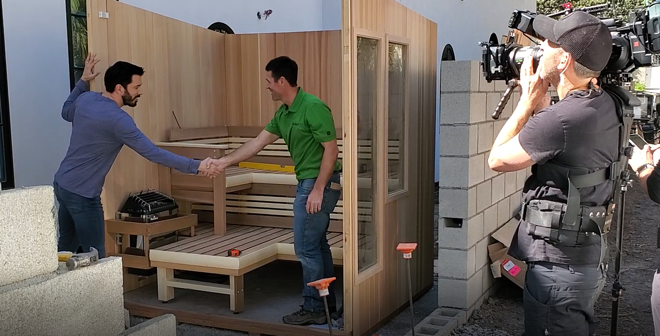
Flatulance is normal.
Erections and reverse (including, to a few peoples horror, the full retreat) are normal, especially in response to heat/cold of sauna.
Talking quietly is OK.
Sitting with other people in total silence is OK. As is healthy debate and discussion.
Yes, people come in all shapes and sizes with all kinds of attachments and decorations and that too is normal.
Variations On A Theme
Sweden – Sauna is called ‘bastu’. While they often have a routine identical to Finland with similar temps and humidity, they will sometimes do the lower temps and higher humidity of a bio-sauna. Swedes also have a reputation for drinking liquor in the sauna instead of the beer or long drink that Finns enjoy.
Continental (Netherlands, Germany, Austria, Switzerland, Northern Italy, Czechia, etc.) – Continental Europe are well known for four things; a strong smell of aromatherapy or infusions, regimented obedience to sand clocks for how long to stay in, hygiene being critical so bathers are required to be textile-free and place a towel under their feet, and with Aufgus a sauna master who is the only one allowed to throw water on the stones.
Americans should note that these are largely all required textile-free (nude) with sexes together.
Continentals actually have kind of four variations of sauna; Finnish, Bio, Aufgus, and Themed.
First is a sauna that is very similar to saunas in Finland with the primary difference being their routine with aromatherapy infusions and sand clocks. These are largely in private residences as well as hotels and other public thermal suites. Similar to Aufguss these will occasionally have lower benches (though this is less and less common with newer seeming to have higher benches) with the expectation that bathers will fan heat and steam down themselves – personal aufgus.
Bio-Saunas (or Bio-Infusion-Saunas) are the same as a Finnish Sauna with the difference being setup with slightly lower temps and a more constant moderately higher base humidity. This is perhaps somewhat similar temps and humidity to a sauna heated by the highly revered Aitokius. In Finland it’s also common for women to sauna first when sauna temps are a bit lower and then the sauna is heated up for the men’s, all-comers or mixed sauna time. So the bio-sauna experience actually has a well regarded history in Finland. In Continental thermal suites they simply dedicate saunas to each of these experiences so that everyone can enjoy either one at any time.
The more constant base humidity can be from a constant drip on the stones or a small steam generator. And just because there is a higher base humidity doesn’t mean that more water can’t be thrown on the stones occasionally for a quick burst of steam.
Aufguss – Possibly originating from the older and similar fanning routine done in the banyas of Russia by bath attendants. A literal translation of Aufguss, pronounced similar to off-goose, is ‘infusion’ but aufguss is more than that. At it’s heart is using a towel, flag or hand fan to create very specific air movement that both mixes and spreads the infusion and evens out temperature and steam stratification. In the video series ‘Perfect Sweat’, Christine Rose points out that there are three kinds of aufgus and Cassandra Cavanah GWI notes that Ritual is a fourth;
- Classical or Traditional – Focused on the sauna experience so air movements are purely to mix in the infusions and reduce stratification.
- Modern – Adds music and a bit more flair to the routines.
- Ritual or Zen – “Take guests on an inward journey, including meditation, yoga, sound bathing or breathwork”.
- Show or Theatrical – Saunamiesters often wear costumes and tell a story.
My personal preference is simple Classical but I still enjoy the others.
These saunas may be built somewhat different than a typical Finnish Sauna. They are partial performance space (a theatre) for the Aufguss master and part of the ritual is the Aufguss master fanning heat and steam down from the ceiling. This is one instance where lower benches work and where bench height is about overall temp rather than evenness. This is often also the case with a less formal Aufguss ritual where anyone in the sauna can perform the fanning with a regular towel (but make sure you know the rules before jumping up and doing it!).
The aufguss meister role began in the 1950’s with their primary responsibility teaching people how to use a sauna properly as sauna was new and few people understood how to do it correctly. And in most cases that is still their primary responsibility today.
A good overview on German saunas is here.
Hay saunas are cropping up more and more often, particularly in the Alps. These again are the same as a typical Finnish sauna except for the addition of hay on the walls. Some smaller spa’s will use the same sauna for Finnish, Bio and Hay by varying the temp/humidity and hanging cribs of hay on the walls for the days that it’s functioning as a hay sauna. Hay saunas can have the moderate temps and higher humidity of a bio sauna or the higher temps and contrasting humidity of a Finnish sauna.
Themed Saunas – Featured in larger sauna worlds throughout central and northern Europe. Note that some of the themed ‘saunas’ are actually more similar to caldariums or laconiums rather than saunas.
Thermal Suites – Larger Sauna Worlds, Sauna Landscapes, Sauna Zones, Wet Areas and Sauna Oasis’ are popular throughout Germany and much of central Europe and spreading elsewhere. One example is Badeparadies Schwarzwald with 12 themed saunas and various mineral pools in their Palais Vital that is part of a larger waterpark. Thermé Erding in Germany, The Well in Norway, AquaWorld in Hungary and dozens more. I have been advising a group who are planning to build one in the U.S. patterned after Thermé Wien in Austria.
Continentals generally prefer a more lingering steam compared to Finns so may not achieve the higher peak humidity that Finns prefer. They are sticklers for hygiene including that bathers must be textile-free and place a towel under their feet. You are also more likely to find cold plunge pools in Continental thermal suites vs Finland.
Croatia – I’m told that following the Continental lead and thanks to better quality saunas and more focus on practice that sauna has recently seen considerable growth in popularity in Croatia.
Denmark, Hungary & Slovenia – These are increasingly similar to Continental above but you may be likely to find a wider variety of not-quite-a-sauna experiences. Sauna and similar thermal experiences have been growing in popularity in Hungary over the past couple of decades, particularly in the area around Lake Hévíz.
Many countries can be very strict about no swimsuits or clothes in saunas. Finns will be polite while eyeing the offender, Swedes will quietly say something while Germans will simply forbid entry or point and yell ‘Aus!’. 🙂
Thermal Suites – Are popular throughout much of Europe. These are sometimes called sauna worlds. These often include at least one and often several saunas, steam baths, thermariums, pools of various temps including cold plunge, salt grottos, relaxation rooms and treatment rooms. Saunas in these are usually well designed. These are sometimes divided in to ‘Continental’ and ‘Nordic’ though often there is little or no difference. Continental require all bathers to be textile-free while Nordic, particularly in Norway, may allow textiles. Nordic are somewhat more likely to have simpler natural foods in their café though both are much tastier and healthy than typical fare in the U.S.
FWIW, I’m a fan of these and the variety they offer. As much as I like true Finnish Sauna I also enjoy steam baths, aufguss, some of the varieties of infusions and other thermal experiences. That said, my preference is towards the lower key places that focus on the experience like those developed by VAMED rather than the Carnival Cruise like environments developed by Thermégroup.
Here is some insight on the Saunas in the North Tyrol of Italy from our most recent visit.
Other Thermal Experiences
Sauna is but one form of Thermal Experience. Banya’s, Sweat Lodges, IR Cabins, Laconiums, Steam Baths and others fill out the world of Sweat Bathing and all worth experiencing.
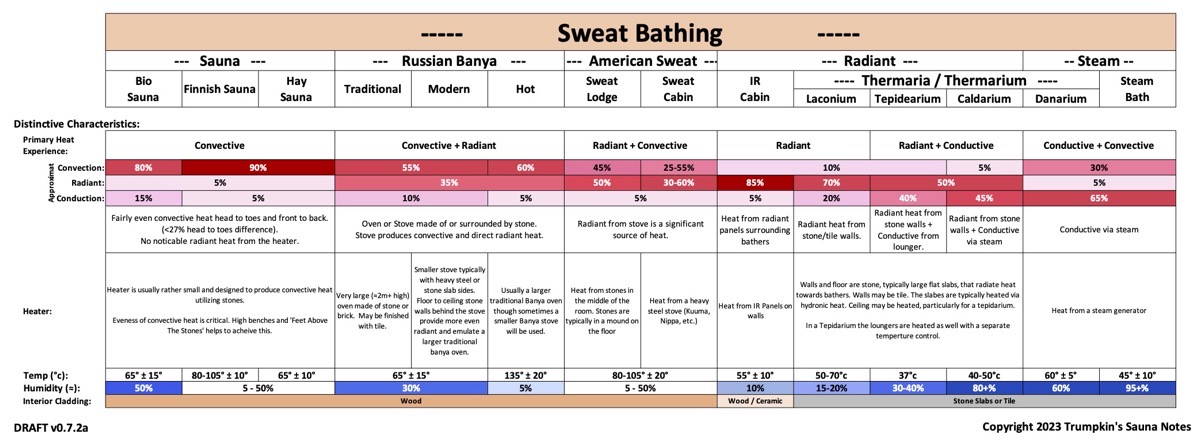
Sauna is unique in being almost exclusively gentle convective heat and, along with steam baths, having no noticeable radiant heat. All other sweat experiences have some noticeable radiant as part of the experience. This is perhaps why sauna has become so popular around the world followed by steam baths.
Interestingly, third in popularity, though a very distant third, may be Laconiums which are primarily radiant heat but a very even from all sides radiant and more comfortable radiant than IR cabins and other sweat bathing experiences. Laconiums are becoming standard elements of thermal suites in Europe.
For a brief and slightly more in-depth overview of these as well as hydro and multi experiences see ‘Other Thermal Experiences’ in the menu above.
Official Definition Of A Sauna
International Sauna Association (ISA) – Adopted at the ISA Congress in Aachen, Germany on 5 Aug 1999
Sauna bath – Saunaing is a healthy and relaxing hot air bath, alternating between warming up and cooling off. When taking a sauna, the whole body is heated several times in a wooden-surface room with a typical temperature of about 80-105 º C, measured from a height of about 100 cm above the level of the upper sitting bench. Warming is followed by cooling in the open air or with cold water.
Sauna room – The sauna is a wood-paneled room with stepped benches, a heater with stones, with a temperature of about 80-105º C measured at a height of about 100 cm above the level of the upper sitting bench, and low humidity, which is briefly added by throwing steam.
References:
Saunologia: The Finnish Sauna Basics
GQ: In Search Of The Perfect Sauna
Womens Health: Sauna Vs Steam Room Benefits
The Truth About Sauna: The Truth About Finns. An interesting (and NSFW) video.
The Perfect Sweat. Mikkel Aaland’s 6 part series on some different sweat bathing cultures. Very highly recommended for those interested in the culture of sauna and sweat bathing.
The Upper Bench podcast: Secrets of Sauna Design with Lassi Liikkanen.
How Does Sauna Design and Practice Affect Health, Wellness and Recovery Benefits.
And Good Books:
Anyone and everyone who is building or buying a sauna should read Lassi Liikkanen’s ‘Secrets Of Finnish Sauna Design’. I’ve read over 60 books on sauna – this is the most accurate and most informative book available. He has an addition to this coming out in Sep 2025 ‘Finnish Sauna: Steam, Wood, Stone and How to Build Your Own’.
Other books largely have dated or inaccurate information from a design standpoint but may have useful ideas on sauna routines, ideas for aesthetics or provide some interesting historical context. Books by Alan Konya, Sakari Pälsi, and H. J. Viherjuuri fit this latter area.
Other Worthwhile Books:
- Sauna: The Finnish Bath (H. J. Viherjuuri)
- Building A Traditional Finnish Smoke Sauna (Hiltunen)
- Social Sauna – Bathing and Wellbeing (Withers)
- Villas and Saunas Of Finland (Hautajärvi)
- The Sauna Book (Johnson & Miller) – Overall good with some good info on construction details. Some info such as on ventilation is quite dated.
- Finnish Sauna: Design & Construction (Rakennustieto Publishing) – Overall good though somewhat dated information. This book is very interesting from a historical perspective but Liikkanen’s book above is largely considered to have superseded it.
- The Modern Sauna (Konya)
- The Businessman’s Guide to Finnish Sauna (Arto Paasilinna)
- The Opposite Of Cold (Nordskog & Hautala) – One of the best coffee table books for those in North America.
- Sauna Studies (various)
- Suomalainen sauna =: The Finnish sauna (Antti Arstila)
- The Sauna Is (Hillala)
- The Best Part of a Sauna (Peterson, Dupre)
- Sweat (Aaland)
- International Handbook of Finnish Sauna (Konya)
- Sauna Magic (Conover)
- Finnish Sauna (Konya)
These are not specific to sauna but worthwhile books for anyone building a sauna.
- Pretty Good House (Maines, Kolbert, Mottram and Briley)
- A House Needs to Breathe…Or Does It? (Bailes)
- Cathedrals Of The Flesh (Brue)
- Thermal Delight in Architecture (Heschong)
- The Architecture of Bathing: Body, Landscape, Art (Pearson)
Various Fun Articles
I cannot attest to the accuracy but overall seem good.
Nordic Perspectives – Ice Bath Guide
Notes
1. Avanto and Ice Baths – Never do it alone. Those with diabetes, heart conditions or just general concerns should consult a doctor before jumping through a hole in the ice. While it is considered safe (and healthy) for the vast majority of people there are a few who should be cautious.
https://journals.asm.org/doi/epub/10.1128/aem.02674-09
2. There is considerable debate about the extent to which Chlorine can remain in a swimsuit. There seems general agreement that going from a chlorinated pool to sauna without showering will often result in unpleasant smells and should be avoided. However, there is evidence on both sides that showering does or does not remove the chlorine. For the vast majority of saunas in swimming halls, swimsuits are forbidden and this is likely a good practice.
